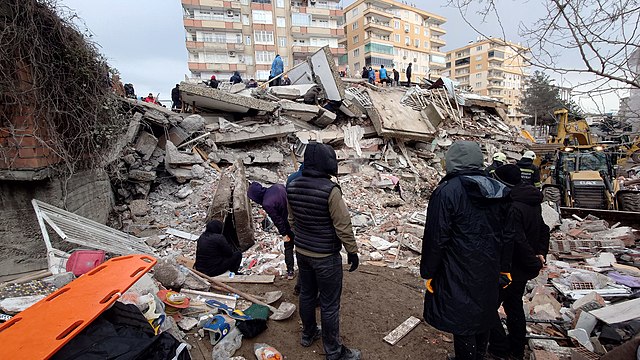Kader, a Turkish word of Arabic origins, describes Allah’s planning of objects and events in eternity, a concept similar to fate. The term is often used in relation to tragedy: When a car crash happens, one may respond, “This was in their Kader”; a woman gets killed, “her Kader was already written”; a person dies under the rubble, “This was all part of the Kader that Allah wrote.”
Growing up in Turkey, Kader has always been part of my vocabulary. However, when President Recep Tayyip Erdoğan announced the resulting destruction of the February 6th earthquake in 2023, Kader began to carry a different weight for me. The 7.7 magnitude quake had resulted in over 100,000 deaths, along with the near destruction of the entire southeast region of the country. According to the President, this was “part of the Kader plan.” However, to his citizens, all the rubble and destruction told a very different story: this was not Kader, but rather a crime.
The label of Kader implies that the earthquake happened by Allah’s design. In reality, it was the state that was the architect of the ruins. Continuing the decades-old practice of issuing zoning amnesties, the government legalized thousands of building structures that violated zoning laws , setting the country’s structures up for failure in the event of an earthquake. These zoning amnesties were usually enacted by the government just before an election, the largest and most comprehensive of which was organized under the “Zoning Peace” law in 2018. All buildings with zoning violations—including those lacking appropriate licensing and those in violation of their original licensing agreement—were offered amnesty under this new law. Since 2018, in the 10 cities that were affected most by the earthquake, 294,166 buildings had been issued zoning amnesty, many of which were among the more than 200,000 buildings damaged or entirely collapsed in the earthquake.
However, no architect works alone—there are layers to the corruption that accentuated the disaster. Kızılay, the Turkish affiliate of the International Red Crescent, strives for “the development of social welfare; providing, presenting and offering services for social solidarity when disaster strikes.” However, during the earthquake, allegations resurfaced of Kızılay selling blood donations, adding to its over 189 million dollars in blood product revenue. Throughout the weeks following the earthquake, Kızılay announced a need for blood due to low stock. During the earthquake, it was also revealed that they had sold their stock of tents—meant for earthquake victims—to private organizations for a sum of 2.4 million dollars. Once again, Kızılay had proven itself to be a company that turns crisis into profit.
All these controversies have raised concerns surrounding the use of funds collected through the “earthquake tax”. Since it was enacted 23 years ago, the tax has raised over 4.63 billion dollars in revenue to finance disaster relief. These funds were supposedly being used to strengthen buildings and bolster disaster relief centers like Kızılay; however, when the funds were most needed following the February 6th earthquake, all of this money seemed to be missing.
It was clear that the government, despite the campaign promises they made 20 years ago, was not prepared at all for the emergency. But their apathy did not stop there: hiding behind the cloak of fatalism, they refused to take responsibility for the ensuing destruction caused by their incompetence. Subverting the definition of Kader, the government used “destiny” as an excuse to leave people under the rubbles. After the first wave of the earthquake hit, nearly no meaningful action was taken. And on top of that, to hide their mistakes, the government blocked all access to social media despite social media channels being an important way to locate their relatives who were trapped under the rubble. After days of no meaningful rescue efforts, officials gave up on the earthquake victims without guilt. Victims laid under the rubble as officials played funeral prayers over their still-living bodies—the government accepting their imminent deaths as an unavoidable destiny, something they could not prevent. “Can anyone hear me?!” was shouted by countless from under the wreckage, pleading for rescuers to locate them. This phrase echoed the despair, desolation, and helplessness that was felt among everyone in the country—a country left under the rubble by its own government.
Now, more than two years since the 6th of February, the effects of the earthquake still reverberate throughout the country. More than half a million people still live in temporary housing accommodations as regions of the country remain completely uninhabitable. Most of the lawsuits that were opened against corrupt building contractors are still underway with concrete answers yet to come; some contractors were simply exonerated of their charges. Some contractors were simply exonerated. Antakya, one of the most affected regions remains completely inhabitable, and Despite recent elections, the government remains unchanged and those responsible for the fallout of the disaster remain atop Turkey’s most powerful institutions. Turkey, a whole two years later, is still under the rubble, left abandoned to its own Kader.
Situated between three tectonic planes, earthquakes are not novel for Turkey. Yet, the government cowers behind the cover of fatalism when tragedy strikes, inhibiting the country from effectively responding to natural disasters. Now, the people of Turkey anxiously await our next Kader, as it seems like we cannot do anything but accept disaster as it comes. 80 percent inflation is in our Kader; 276 femicides a year are in our Kader; disastrous fires are in our Kader, we cannot even escape mining disasters. All of our suffering, oppression, poverty, anger, frustration and weariness are all part of our God-given Kader. All this mention of the word reminds me of the graffiti I saw everyday as I walked back home: “If it is Kader, why are we the only ones that are suffering?”
